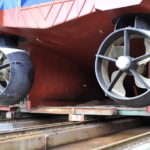In May Rolls Royce has celebrated 50 years since the delivery of its first azimuth thruster. Today it is one of the company’s most successful and important products. Now Rolls Royce is presenting a new azimuth thruster using permanent magnet technology.
Rolls Royce has a long history of azimuth thrusters installed in small tugboats or in some of the world’s largest[ds_preview] drillrigs. »Azimuth thrusters are attractive for ship designers because of the flexibility they offer when placing them«, Jarle M. Hessen, Senior Advisor, Offshore E&P, Propulsion, explains.
Over the years the thrusters evolved, nozzles were added and efficiency was improved. With the times changing, also the needs altered: more power, less noise, better efficiency. »Curently owners are asking a lot for longer maintenance intervals«, Hessen points out the new challenge for azimuth thruster development. To further increase efficiency and ease of maintenance, the company now adapts the permanent magnet (PM) technology to the already proven propulsion concept.
The PM-technology is already successfully in use in tunnel thrusters. Like in other rim driven thrusters, the permanent magnet (PM) azimuth thrusters do not need a gear and shaft anymore. The motor is located in the nozzle and the ring surrounding the propeller bears the permanent magnets. A rotating electric field then rotates the propeller around a center bearing needed for stability. Thus no additional electric motor inside the ship is needed.
Because of the permanent magnets, no eletrical contact exists between the motor and the rotating propeller anymore, which reduces the negative effects of induction motors. At the same propeller diameter, the power output is about 25% above that of non-PM rim thrusters, Gunnar Johnsen, head of Electrical Systems Research & Technology, states.
The new concept is tested in collaboration with researchers from the university of Trondheim (NTNU), Norway. The first ship so far equipped with PM azimuth thrusters is the NTNU’s research vessel »Gunnerus«. The conventional azimuth thrusters were replaced with two 500 kW PM-thrusters with a diameter on 1.9m each. It already shows that noise and vibration levels are far below those known of conventional systems. The fact that there is no gap between the tips of the propeller blades and the nozzle prevents tip loss and reduces cavitation.
Being in operation for a short time only, no data concerning lifecycle costs are availabe so far, Johnsen explains. But it is obvious that maintenance costs of the PM thrusters will be lower than these of conventional azimuth trusters. »We only have very few moving parts in this system«, Gunnar Johnsen, Head of Electrical Systems R&T, explains. »In fact it is only one, the propeller.« Additionally reduced vibration and cavitation should reduce abrasion and erosion of the metal.
According to Johnsen, first test runs with the »Gunnerus« showed that efficiency has significantly improved, compared to conventional azimuth thrusters. The power savings reach from 13% at 8.8kn to 7% at full speed of 11.5kn.
There is another advantage especially for shipbuilders and designers: Since the electric motor is integrated into the nozzle of the thruster or the tunnel of a tunnel thruster, there are significant space savings. The maintenance friendly technology is also being tested for deck machinery applications, such as winches for trawlers. »Maybe this technology is the future«, Jarle M. Hessen says.
Felix Selzer




















